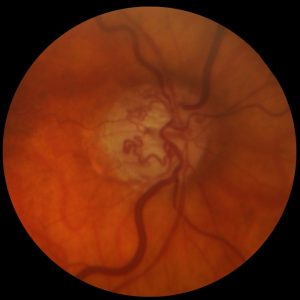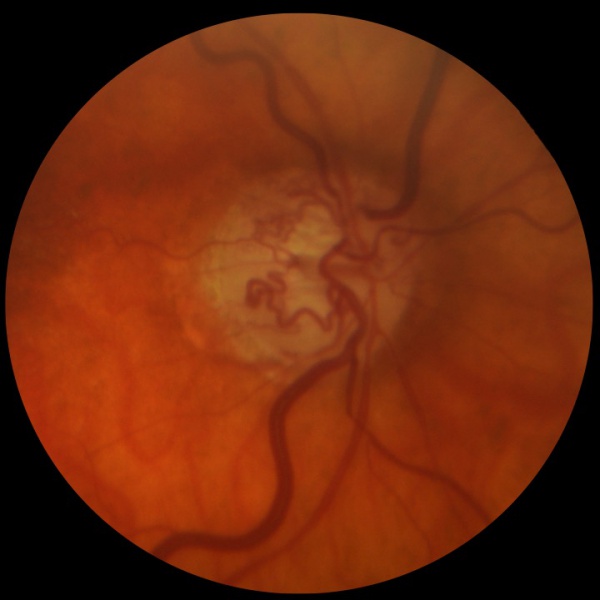CASE REPORT
Case of Optociliary Shunt Vessels a 46-year-old man complained of severe visual loss starting 2 years earlier, originally without headache or eye pain. The first manifestation was transient visual obscuration. This was followed a few months later by the loss of the peripheral field, but with preservation of central vision.

Six months before the first examination, severe headache set in, associated with reduced central vision. The patient’s body mass index (BMI) was 26.5 kg/m2.
Upon examination, visual acuity was no light perception in the right eye and hand movements in the temporal field of the left eye. The pupillary light reflex was poor in both eyes. No abnormality was seen on biomicroscopy, and the intraocular pressure was 12 mm Hg in both eyes.
The fundus examination revealed atrophic optic nerve and optociliary shunt vessels in both eyes.
DISEASE of Optociliary Shunt Vessels
This disease also known as retinochoroidal shunt vessels of the optic disc or retinochoroidal collaterals, are collateral vessels on the optic nerve that connect the choroidal and retinal circulations.
They are associated with multiple conditions including central retinal vein occlusion, optic nerve sheath meningioma, chronic glaucoma, and chronic papilledema.

MANAGEMENT of Optociliary Shunt Vessels
Work-up and treatment are directed towards the underlying etiology. Optociliary shunt vessels classically do not disappear. However, various case reports have demonstrated shunt vessels to decrease in caliber or even completely involute after treatments that improve blood flow through the central retinal vein.
Another possibility is that the development of optic atrophy results in a thinner nerve with less obstruction, allowing a decrease in the central retinal vein pressure and lessening the driving force for blood flow through the optociliary collateral vessels.
The regression of optociliary shunt vessels has been documented in cases of pseudotumor cerebri successfully treated with optic nerve sheath fenestration.
would you have the interest to take retina images by smartphone?
Fundus photography is superior to fundus analysis as it enables intraocular pathologies to be photo captured and encrypted information to be shared with colleagues and patients.
Recent technologies allow smartphone-based attachments and integrated lens adaptors to transform the smartphone into a portable fundus camera.
More report cases of Aicardi syndrome, Choroidal Folds, Choroidal Osteoma, Cornea Verticillate.
REFERENCES
- Fraser CL, Ridha MA, Biousse V, Newman NJ. Vitreous hemorrhage secondary to optociliary shunt vessels from papilledema. J Neuroophthalmol. Dec 2012;32(4):332-4. doi:10.1097/WNO.0b013e31825ba161
- Lee JJ, Yap EY. Optociliary shunt vessels in diabetes mellitus. Singapore Med J. Apr 2004;45(4):166-9.
- Takahashi K, Muraoka K, Kishi S, Shimizu K. Formation of retinochoroidal collaterals in central retinal vein occlusion. Am J Ophthalmol. Jul 1998;126(1):91-9. doi:10.1016/s0002-9394(98)00069-5.
- Muci-Mendoza R, Arevalo JF, Ramella M, et al. Optociliary veins in optic nerve sheath meningioma. Indocyanine green videoangiography findings. Ophthalmology. Feb 1999;106(2):311-8. doi:10.1016/s0161-6420(99)90055-6.
- de Alba Campomanes AG, Larson DA, Horton JC. Immediate shrinkage of optociliary shunt vessels after fractionated external beam radiation for meningioma of the optic nerve sheath. AJNR Am J Neuroradiol. Aug 2008;29(7):1360-2. doi:10.3174/ajnr.A1063.
- Interlandi E, Pellegrini F, Papayannis A, et al. Optical Coherence Tomography Angiography Findings in Optic Nerve Sheath Meningioma. Case Rep Ophthalmol. 2020;11(2):364-369. Published 2020 Jul 14. doi:10.1159/000508411
- Singh A, Agarwal A, Mahajan S, Karkhur S, Singh R, Bansal R, Dogra MR, Gupta V. Morphological differences between optic disc collaterals and neovascularization on optical coherence tomography angiography. Graefes Arch Clin Exp Ophthalmol. 2017 Apr;255(4):753-759. doi: 10.1007/s00417-016-3565-x. Epub 2016 Dec 9. PMID: 27942950.

RETINAL IMAGING BY YOUR SMARTPHONE



